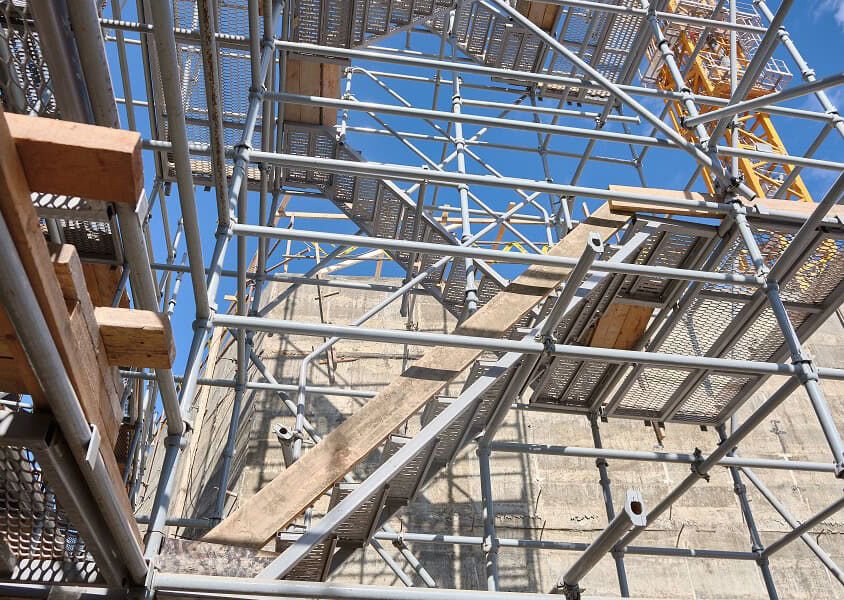Exploring the Different Kinds Of Scaffolding Used in Construction Projects
The building and construction sector relies greatly on various types of scaffolding to satisfy particular task requirements, each offering distinct advantages and applications. Standard framework scaffolding supplies a tough structure for general jobs, while put on hold scaffolding is important for work on skyscraper frameworks.

Traditional Framework Scaffolding
Standard frame scaffolding is one of one of the most widely utilized approaches in the building industry as a result of its toughness and convenience. This system contains vertical and horizontal structures that are assembled to create a secure platform for products and workers. The major components include vertical articles, horizontal ledgers, and angled braces, which with each other offer a strong framework that can sustain significant tons.
One of the crucial benefits of standard frame scaffolding is its versatility to different building and construction tasks, ranging from property structures to huge industrial frameworks. The modular layout enables very easy assembly and disassembly, making it efficient for both lasting and short-term jobs. In addition, the system can be tailored in height and width, accommodating various structure styles and website problems.
Safety and security is paramount in scaffolding applications, and standard frame systems are geared up with guardrails and toe boards to avoid falls and make sure worker protection. Routine evaluations and adherence to safety regulations are critical in preserving the integrity of the scaffold (Scaffolding). Overall, traditional frame scaffolding remains a fundamental selection in the building sector, giving a trusted system for labor and improving general job effectiveness

Suspended Scaffolding
Put on hold scaffolding supplies a special solution for building tasks that need access to raised surface areas, particularly in situations where typical frame scaffolding may be not practical. This kind of scaffolding is normally put on hold from the roof or upper levels of a framework, making use of a system of ropes, platforms, and wheels to develop a working space that can be gotten used to numerous elevations.
One of the main advantages of put on hold scaffolding is its versatility. It can be easily repositioned or lowered to fit changes in building demands, making it ideal for tasks such as home window installation, façade job, and upkeep on skyscrapers. In addition, the marginal impact of put on hold scaffolding enables for better usage of ground area in metropolitan settings, where room is often limited.
Safety and security is a crucial factor to consider in the usage of suspended scaffolding. Generally, put on hold scaffolding offers a efficient and reliable service for accessing hard-to-reach locations in different construction circumstances, enhancing both productivity and security on website.
System Scaffolding
System scaffolding, often regarded as a contemporary service in the scaffolding industry, includes pre-engineered elements that can be quickly constructed and adapted for different construction tasks. Scaffolding. This kind of scaffolding is defined by its modular style, which permits convenience and effectiveness on work sites, accommodating various heights and structural requirements
Commonly made from high-strength steel or light weight aluminum, system scaffolding offers improved durability and security. The elements consist of vertical messages, straight journals, and diagonal braces, which adjoin safely, guaranteeing a durable structure. The design typically integrates standard fittings, simplifying assembly and disassembly procedures, consequently lowering labor time and costs.

Rolling Scaffolding
Rolling scaffolding is a functional option to traditional fixed scaffolding, designed for flexibility and simplicity of use on building and construction sites. This sort of scaffolding contains a platform sustained by scaffold key structures with wheels, go enabling workers to quickly relocate it as needed. The flexibility function considerably boosts efficiency, as it lessens downtime related to dismantling and assembling repaired scaffolding.
Typically built from light-weight materials such as light weight aluminum or steel, rolling scaffolding offers a strong yet mobile remedy for tasks requiring regular repositioning - Scaffolding. It is specifically beneficial in tasks such as paint, drywall installment, and electrical work, where accessibility to various elevations and areas is required
Safety and security is extremely important in rolling scaffolding design, with functions such as securing wheels to prevent unexpected movement when being used, and guardrails to shield workers from falls. Additionally, numerous designs are flexible in elevation, accommodating different task needs.
Cantilever Scaffolding

The design of cantilever scaffolding typically entails using braces or arms secured to a building or framework, enabling the system to expand exterior safely. Safety and security is critical; hence, these scaffolds should be engineered to stand up to various lots and environmental problems. Normal examination and maintenance are crucial to make sure structural stability and employee safety.
Cantilever scaffolding is favored for its adaptability and effective scaffold osha 1926 use space, making it a prominent selection in metropolitan environments where room restraints prevail. It assists in less complicated access to high altitudes, inevitably contributing to the overall performance of building jobs. Just like all scaffolding kinds, correct training and adherence to security criteria are critical for workers utilizing cantilever scaffolding.
Final Thought
Standard frame scaffolding offers security, while put on hold scaffolding uses flexibility for elevated jobs. System scaffolding facilitates quick setting up, and rolling scaffolding improves mobility for varying work environments.
Typical framework scaffolding offers a sturdy foundation for basic tasks, while put on hold scaffolding is necessary for work on high-rise frameworks.Rolling scaffolding is a versatile option to standard fixed scaffolding, designed for flexibility and simplicity of usage on construction websites. As with all scaffolding types, correct training and adherence to safety standards are crucial for workers making use of cantilever scaffolding.
Conventional frame scaffolding provides security, while suspended scaffolding uses versatility for elevated tasks. System scaffolding promotes quick setting up, and rolling scaffolding boosts wheelchair for varying job environments.
Comments on “Dependable Domestic Scaffolding for Homeowners in Need of Safe Renovations”